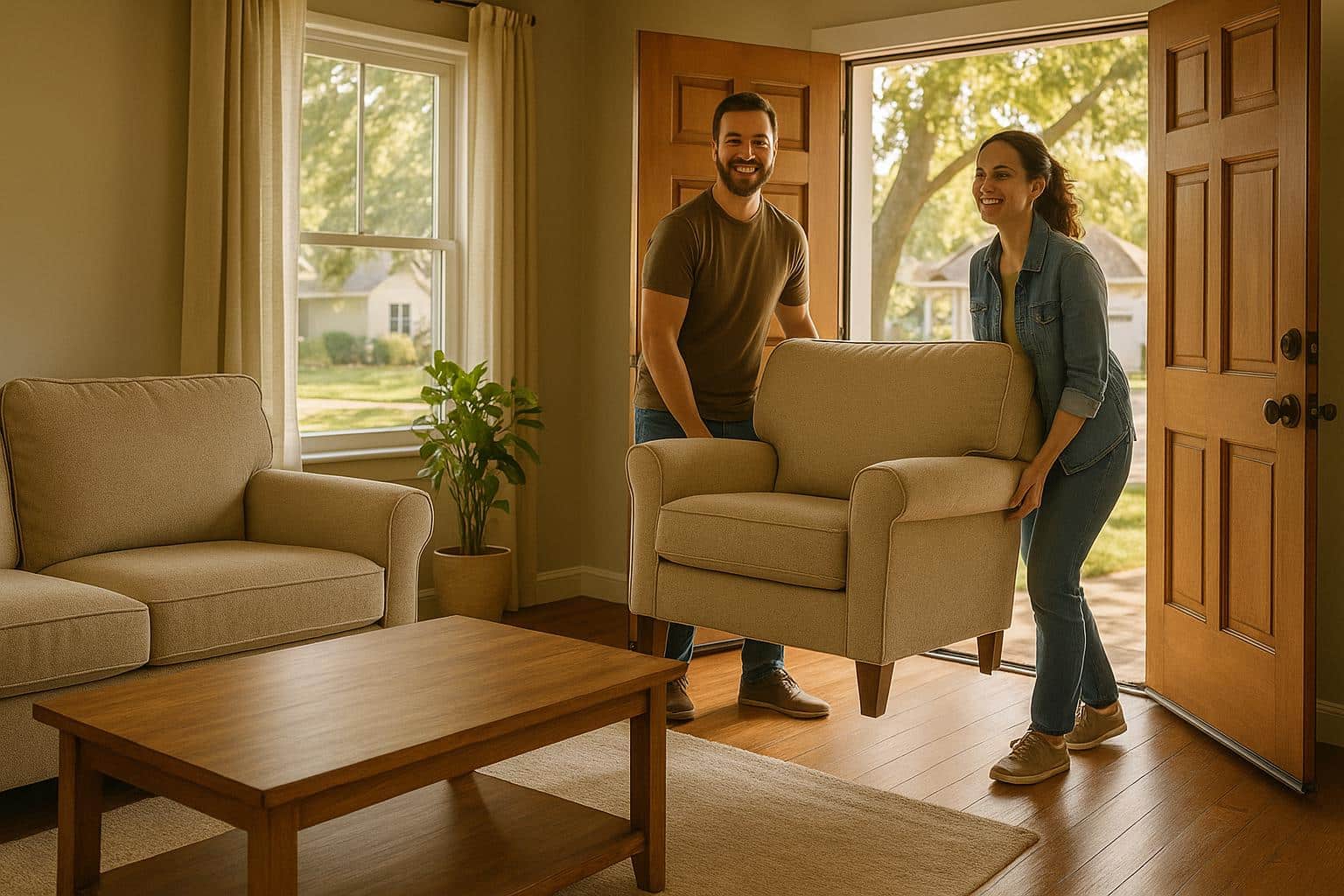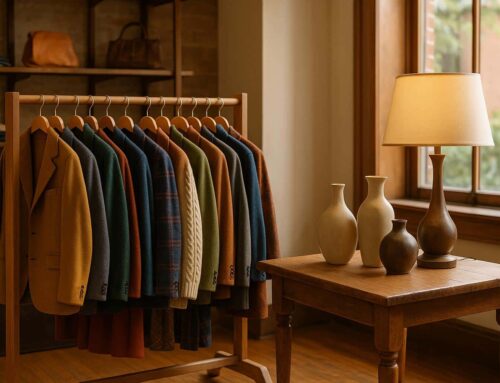Donating used furniture is a simple way to help your community, reduce waste, and even save money through tax deductions.
Here’s what you need to know:
- Why Donate?
Your furniture donations support local programs, provide affordable options for families in need, and reduce landfill waste. For example, City Thrift in Kansas City helps families transitioning out of homelessness while creating jobs. - What’s Accepted?
Items like sofas, tables, bookshelves, and lamps in good condition are welcome. Items with stains, tears, or structural damage, as well as mattresses and baby cribs, are not accepted. - How to Prepare?
Clean and inspect your furniture. Tighten loose parts, remove personal belongings, and disassemble large items for easier transport. - Where to Donate?
Drop off your furniture at City Thrift locations in Kansas City or schedule a pickup for large items by calling their service.
Donating furniture turns empty houses into homes, helps the environment, and supports families in need. Ready to make a difference? Start by cleaning and preparing your items today!
Accepted Furniture Types
City Thrift accepts furniture donations that are in good condition to help support local programs. Knowing what is and isn’t accepted ensures your contributions make a positive impact.
Standard Accepted Items
| Category | Examples | Required Condition |
|---|---|---|
| Living Room | Sofas, Armchairs, End Tables | Clean and structurally sound |
| Dining Room | Tables, Chairs, Buffets | Stable with all parts intact |
| Storage | Bookshelves, Dressers, Cabinets | Functional drawers and doors |
| Home Office | Desks, Office Chairs | Fully operational |
| Decor | Lamps, Mirrors, Wall Art | Complete and ready to use |
Furniture outside these conditions cannot be accepted.
Items Not Accepted
If the furniture doesn’t meet the above standards, the following items are excluded:
- Safety-Regulated Items:
- Baby cribs
- Mattresses and box springs
- Bed pillows
- Condition-Based Exclusions:
- Items with stains, tears, unpleasant odors, or structural damage
- Furniture affected by mold or mildew
For questions about items not listed, contact your nearest City Thrift location. Following these guidelines ensures your donation can truly make a difference.
Preparing Items for Donation
Cleaning Steps
Before donating furniture to City Thrift, giving it a proper clean helps maintain quality and makes it more appealing to buyers. Here’s how to clean your items effectively:
For hard surfaces:
- Use a disinfectant cleaner or mix equal parts water and white vinegar.
- Wipe down all surfaces, including hidden spots like undersides and corners.
- Pay extra attention to high-touch areas such as handles and armrests.
For upholstered items:
- Vacuum thoroughly, including crevices and underneath cushions.
- Spot-clean stains using a cleaner suited to the fabric type.
- Make sure everything is completely dry before transporting.
Once cleaned, inspect the furniture for any damage to ensure it’s ready for donation.
Inspecting for Damage
Take time to carefully examine your furniture to confirm it meets donation standards. Use this checklist to guide your inspection:
| Component | What to Check | Action Needed |
|---|---|---|
| Structure | Stability and wobbling | Tighten any loose joints |
| Hardware | Handles, hinges, screws | Replace missing or broken parts |
| Surfaces | Scratches, dents, stains | Clean or make minor repairs |
| Fabric | Tears, worn spots, odors | Ensure it’s free of major damage |
| Drawers/Doors | Smooth operation | Fix alignment or functionality |
Taking Apart Large Items
Disassembling large furniture can make transportation easier and prevent damage. Gather these tools before starting:
- Screwdriver set
- Pliers
- Rubber mallet
- Work gloves
- Safety glasses
Steps to follow:
- Remove cushions and any detachable parts first.
- Label all components and store screws or small hardware in sealed bags.
- Take photos of assembly points to simplify reassembly later.
- Wrap fragile pieces separately to protect them during transit.
Donation Locations
City Thrift has several donation centers in the Kansas City area, making it easy to drop off your items:
| Location | Hours |
|---|---|
| Overland Park | Mon-Sat: 9 AM – 9 PM Sun: 10 AM – 8 PM |
| Shawnee | Mon-Sat: 9 AM – 9 PM Sun: 10 AM – 8 PM |
| Waldo | Mon-Sat: 9 AM – 9 PM Sun: 10 AM – 8 PM |
| Blue Springs | Mon-Sat: 9 AM – 9 PM Sun: 10 AM – 8 PM |
| Lawrence | Mon-Sat: 9 AM – 9 PM Sun: 10 AM – 8 PM |
These locations accept quality furniture donations, which help fund City Union Mission‘s community programs. It’s always a good idea to call ahead before dropping off your items.
Local Donation Options
Can’t make it to a drop-off center? Reach out to your nearest City Thrift store to explore other donation options. If transportation is an issue, consider using the pickup service.
Furniture Pickup Services
Got large or multiple items? Schedule a pickup by calling:
- (816) 641-5656
- (816) 474-9380, ext. 5062
When scheduling, provide details about the furniture, list any additional items, share your address and preferred pickup dates, and ensure everything is easy to access on the pickup day.
Why Donate Furniture
Community Impact
When you donate furniture to City Thrift, you’re directly supporting community programs run by City Union Mission. These donations help provide affordable furniture to families facing financial challenges while also funding initiatives for low-income households.
The benefits are clear – your contributions assist families transitioning out of homelessness by helping them furnish their new homes. On top of that, thrift store operations create local jobs, bolstering the community’s economic stability. Every piece of furniture sold goes toward funding local projects.
And there’s more: donating furniture helps reduce waste that would otherwise harm the environment.
“Donating furniture gives gently-used pieces new life, minimizes environmental impact, and supports important social and community initiatives.” – City Thrift
Reducing Waste
Furniture donation doesn’t just benefit people – it also helps the planet. By donating, you reduce the environmental damage caused by furniture waste.
| Environmental Impact | Statistics |
|---|---|
| Annual Furniture Waste | 12 million tons |
| Mattresses Discarded Yearly | 18.2 million |
| CO2 Emitted by Incinerating One Mattress | 48 kilos |
Discarded furniture often ends up in landfills, where it can take years to decompose and pollute the soil. Donating prevents this. For example, reusing just 4,250 mattresses kept 204,000 kilos of CO2 out of the atmosphere. That’s a significant step toward reducing environmental harm.
Tax Benefits
Donating furniture can also save you money through tax deductions. Here’s what you need to know:
- Documentation Requirements
Keep records of your donations, including: - Condition Standards
The IRS requires donated furniture to be in “good used condition or better” to qualify for tax deductions. This ensures that charities receive items they can put to use.
For detailed guidance on valuing your donated furniture, refer to IRS Publication 561, “Determining the Value of Donated Property”. Keep in mind, these deductions are only available if you itemize your taxes instead of taking the standard deduction.
Next Steps
Thinking about donating? Here’s how to make the City Thrift donation process simple and hassle-free:
1. Get Your Furniture Ready
- Wipe down all surfaces to ensure they’re clean.
- Check for any loose or missing parts.
- Remove all personal belongings.
- For larger pieces, disassemble them to make transportation easier.
2. Keep Records
- Snap clear photos of your items for tax documentation.
- Find and include any assembly instructions, if available.
- Once everything is prepped and documented, you’re ready to move on to scheduling your donation.
3. Schedule Your Donation
Pick the option that works best for you:
| Donation Method | Details | Hours |
|---|---|---|
| Drop-off | Bring your items directly to City Thrift | Mon–Sat: 9 AM – 9 PM Sun: 10 AM – 8 PM |
| Pickup Service | Call (816) 641-5656 to arrange a pickup | Available for large items |
Not sure if your furniture is eligible for donation? Reach out to your nearest City Thrift location to confirm their guidelines before heading out.
Final Tips
- Double-check drop-off hours to avoid any inconvenience.
- Don’t forget to ask for a donation receipt – it’s useful for tax purposes!
FAQs
How can I make sure my furniture donation qualifies for a tax deduction?
To ensure your furniture donation qualifies for a tax deduction, start by obtaining a donation receipt from the charity. The receipt should include a description of the items, the date of the donation, and the charity’s name. This documentation is essential for your tax records.
If the total value of your donated items exceeds $500, you’ll need to complete IRS Form 8283 when filing your taxes. To estimate the value of your furniture, consult donation valuation guides or similar resources. Remember, the IRS requires that all donated items be in good used condition or better to qualify for a deduction.
By following these steps, you can maximize the impact of your donation while ensuring it meets tax deduction requirements.
How does donating furniture to City Thrift support the community and protect the environment?
Donating your furniture to City Thrift has a powerful impact on both your local community and the environment. It helps provide affordable furniture options for families in need and supports local job creation. Your donations also contribute to meaningful causes, such as education programs and disaster relief efforts.
On an environmental level, donating furniture keeps items out of landfills, reducing waste and conserving valuable resources. By giving your furniture a second life, you’re making a positive difference for both people and the planet.
Can I donate furniture with minor damage?
Yes, you can donate furniture with minor damage as long as it’s still in usable condition. Many organizations accept items with small imperfections, like scratches or loose screws, as long as they are safe and functional.
Before donating, take a moment to clean the furniture and make simple fixes, such as tightening screws or stabilizing wobbly legs. This extra effort helps ensure your donation is ready for someone else to enjoy and makes a positive impact on your community.







Leave A Comment